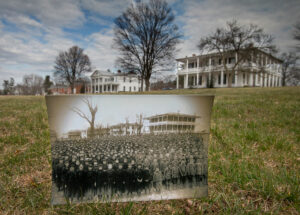It was March 25, 1911, in New York City. It was a Saturday afternoon just like any other at the Triangle Shirtwaist factory, where young immigrant women sat in front of sewing machines, day in and day out, sewing. But on that day a fire broke out, causing the deaths of 146 garment workers. Among those who died in the flames and smoke were 123 women and 23 men.1 Many even jumped or fell to their deaths out the windows, making this event a man-made disaster and one of the deadliest industrial disasters of all time.

The factory was located in the Asch Building at Washington Place in Greenwich Village, one of the wealthiest neighborhoods in the city. The factory occupied the eighth, ninth, and tenth floors of the ten-story building. Max Blanck and Issac Harris were the owners of the factory, and their company was known as the largest firm in the business at the time. They styled women’s blouses known as “Shirtwaists,” which were paired with tailored skirts. This attire had become the standard in fashion for women in the early twentieth century. They were also known to resemble men’s shirts. When it came to their workers, they had hired operators who then contracted out for factory workers. The company itself only dealt with the contractors, and there was no fixed rate of pay for the workers.2 At the time, the factory employed about five-hundred employees, mostly young immigrant women who were of Italian or Jewish descent. These women worked up to eleven-hour shifts on weekdays, and twelve-hour shifts on Saturdays, and they earned between $7-$12 dollars for a 52-hour week. Many of these women were the breadwinners of their household, and their income was sometimes not sufficient to cover their needs.
Towards the end of the workday on that Saturday evening in 1911, a fire broke out around 4:00 pm. The fire started in a scrap bin under one of the cutter’s tables on the eighth floor from what is believed to have come from a cigarette. A manager tried to put the fire out with a hose but the hoses valve was rusted shut, and rotten away. The fire spread quickly and the workers panicked. There was one fire escape that quickly collapsed, and four elevators, which out of the four only one was working. The elevator held twelve people at a time, and it managed to make four rescue trips before it broke down.3 With no other alternatives available, people began throwing themselves out the windows, and some were even crushed to death trying to get out. Workers tried to take the stairs, but the exit doors only opened inward and were kept locked by factory management to prevent theft by the workers, as the managers would check their workers belongings every day before they left for the day.

Celia Saltz Pollack, a survivor of the 1911 Triangle Shirtwaist Fire said,
I remember on that day there was a lot of singing and happiness in the shop because it was the end of the week and we got paid. We were soon all going to go home. When the fire started I was sitting at my machine. I looked up and saw the fire near the cutting tables but I did not think it was so terrible. What was terrible was that the fire spread in a split second.
By the time the firefighters arrived, they came to the realization that their ladders could only extend up to the sixth or seventh floors. With no other option, sixty-two workers jumped and fell to their deaths, while the remaining died from the smoke and flames within the building.4

This fire not only pushed issues of unsafe factories and immigrant exploitation into the public consciousness, but for the first time the fire allowed for attention to be brought to deplorable conditions of New York factories.5 Women obtained well deserved attention onto current work conditions and safety measures in the workplace. Although the Triangle Shirtwaist Factory fire brought a feeling of resentment and heartbreak to many, this event and its victims will always be remembered.
- Ric Burns, “Triangle Shirtwaist Fire,” New York Times (1923-Current File), Nov 24, 1999. ↵
- Jonathan Fink, “Conflagration and Wage: The Triangle Shirtwaist Factory Fire, 1911,” TriQuarterly, no, (2009): 135-136. ↵
- Gale Encyclopedia of U.S. Economic History, s.v. “Triangle Shirtwaist Fire,” by Thomas Carson and Mary Bonk. ↵
- Mia Lynn Mercurio, Régine Randall, “Tributes Beyond Words: Art Educators’ Use of Textiles to Memorialize the Triangle Shirtwaist Factory Fire.” Journal for Learning through the Arts no. 1 (2016): 4-5. ↵
- Albert Marrin, Flesh and blood so cheap: The Triangle fire and its legacy (New York: Alfred A. Knopf, 2011), 23-25. ↵




135 comments
Vanessa Rodriguez
I really enjoyed the article. It really made me realize how important fire safety is and I loved how in detail it was. It definitely should be taught everywhere since there is a high death count because of it. It is so sad to see how much disasters took place, but sadly because it happened, so many more limits and regulations were put into place and we learned from it. Amazing article.
Iris Reyna
The article was written very well and the author hooked you in with a strong intro. You did a very good job of portraying this tragic event in history. I was really intrigued reading this article but it made me angry and frustrated because this could have been prevented if the safety of the workspace and building were improved. See that photo made it so much worse to envision what the workers went through. The 123 women and 23 men that died that day could have lived but people rather focus on their pockets than the well-being of the people.
Rosalyn Ledesma
First off, great article! Second, I want to say I learned about this last semester and how this sparked the reason why exit doors like that push out and not in. That way, when there happens to be a tragic event like this and people are rushing to exit, they can easily push the door to get out. Otherwise, it becomes difficult to pull the door in when there is tons of people shoving you to get out. It’s so sad that those innocent people lost their lives, but the changes made after possibly saved so many more.
Jacob Anthony Ayala
Hi, Josselyn, this was a very well-written and articulated essay! This was truly a very tragic event in US history. It is so sad to think about how they cared only about productivity back then over the safety of human life. This tragic event put into perspective how far we’ve come in this country regarding the safety of the work environment.
Nnamdi Onwuzurike
It’s crazy that the owners would lock the workers in the building all day. I just wonder what happened to the reputation of the company and owners as well. The firefighters not being able to get to the higher floors also goes to show how fast development was during the Progressives. I really enjoyed this article. It tells the entire story in a short and efficient way.
Guiliana Devora
It is so crazy to think about how this natural disaster caused so many deaths and it was only because management did not want people to go on breaks. The only good thing that came from this disasterous event was the fact that it brought national attention to working conditions for women and the factories in general and how they were being treated.
Maggie Trujillo
This was a good article about the Shirtwaist Factory. I don’t think I have heard about it before – until I read this article. Such a sad story to hear about everything going wrong when they were trying to escape – water hoses rusted and shut off, stair doors locked, and fire ladders not reaching them. All this happened on a Saturday afternoon right before they were about to get off and enjoy what they had left of the weekend. Unfortunately, it took this tragedy to shed light and awareness that working conditions in factories and immigrant exploitations. With this fire, it also brought forth better safety precautions in workplaces.
Laurel Cox
This article is a great depiction of what life was really like for industrial workers before labor laws and successful labor unions; the fact that there was no way out for the workers shows the true intentions of the company owners, the true disregard for human lives, which seems to be a common theme throughout American history. It’s difficult to believe and imagine people stuck inside a burning building with locked doors and no way to escape but to jump.
Isabel Soto
First off why would they build a building witch had little to no escape exits and poor maintenance. So for something to like a fire was very difficult to escape .this article shared that when the fire started all worker where trap in. it is very sad that this building was built terrible and never kept well maintenance. But congrats on getting your article published i love reading and being informed about what happen durning this time period.
Maria Luevano
I have heard about this incident a few times throughout my history classes, and every time it is a shock to read about. This is such a sad and tragic incident, but it would allow for the process of reform to take place and better the laborers’ work environment. The author did a great job explaining the aftermath of the fire and the events happening during the fire and an added bonus of a quote from a survivor.